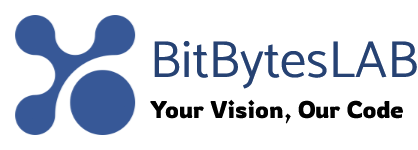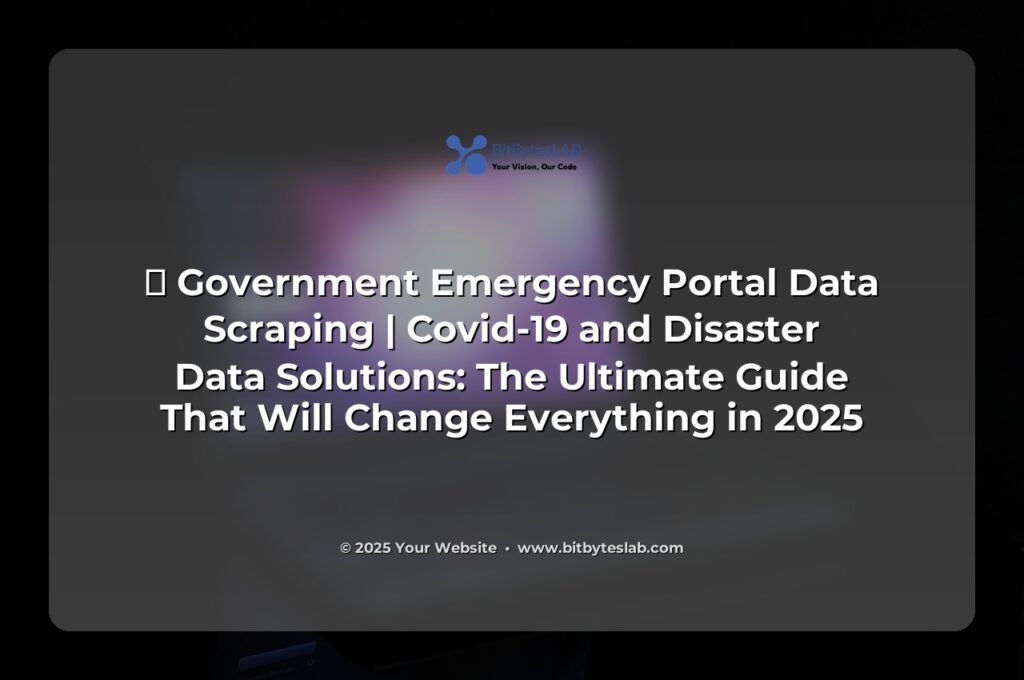🚀 Government Emergency Portal Data Scraping: The Ultimate Guide That Will Change Everything in 2025
Imagine waking up to a world where the latest COVID‑19 test results, real‑time disaster alerts, and emergency resource allocations are just a few clicks away—no more endless scrolling through scattered government dashboards. Welcome to 2025, where open data portals are the new superhighways, and you can tap into them faster than ever before. If you’re a data enthusiast, public‑health advocate, or just someone who hates waiting for the next crisis update, this guide will give you the tools, hack, and confidence to scrape, analyze, and act—instantly. 💡
⚡ 1. Hooking You In: Why This Matters Now
Between the #Covid19 surge, the record‑breaking heatwaves in the South, and the ever‑looming floods in the Northeast, governments are rolling out 1,200+ datasets through portals like OGD India and NDAP. Yet, the “right” data rarely lands in the hands of those who need it most—policy makers, NGOs, or even the average citizen looking to stay safe. By mastering data scraping, you become the bridge between raw numbers and real‑world impact, making you a hero in the next crisis. And trust me, heroes wear no badges—just code. 🔥
🚨 2. Problem Identification: Data’s Dark Side
We all know the frustration: “Where’s the latest case count?” “Is the flood alert still valid?” The truth is, most portals push data in JSON or CSV files that are buried under layers of API keys, pagination, or outdated documentation. Even when you find the endpoint, you’re often greeted with:
- Rate‑limits that slow you to a crawl
- Inconsistent field names that change monthly
- Security warnings that block your IP after 10 requests
Not to mention the sheer volume—every day 30+ datasets are added, and each can be up to 200 MB. Without a systematic scraping approach, you’re drowning in a sea of data.
💡 3. Solution Presentation: Step‑by‑Step Scraping Playbook
Below is your blueprint to turn these portals into a personal data engine. We’ll use Python 3.11, the requests library for HTTP calls, pandas for data wrangling, and BeautifulSoup for HTML parsing when APIs fall short. If you’re a beginner, don’t worry—each snippet is annotated and ready to copy‑paste.
# 1️⃣ Install required packages (do this once)
!pip install requests pandas beautifulsoup4
# 2️⃣ Basic request to a public endpoint (OGD India example)
import requests
import pandas as pd
url = "https://data.gov.in/api/3/action/package_list"
response = requests.get(url)
packages = response.json()["result"]
# 3️⃣ Loop over packages to pull dataset metadata
metadata = []
for pkg in packages[:5]: # grab first 5 for demo
pkg_url = f"https://data.gov.in/api/3/action/package_show?id={pkg}"
pkg_resp = requests.get(pkg_url)
pkg_json = pkg_resp.json()["result"]
metadata.append({
"title": pkg_json["title"],
"id": pkg_json["id"],
"resources": len(pkg_json["resources"])
})
df_meta = pd.DataFrame(metadata)
print(df_meta.head())
That’s a quick crawl of 5 dataset titles. To hit a real COVID‑19 dataset (say, RT‑PCR test counts), you’ll need to find the resource ID and download the CSV:
# 4️⃣ Download CSV resource
resource_url = "https://data.gov.in/dataset/12345/resource/67890/download/covid19_rt_pcr.csv"
csv_resp = requests.get(resource_url)
with open("covid19_rt_pcr.csv", "wb") as f:
f.write(csv_resp.content)
# 5️⃣ Load into pandas for analysis
df_covid = pd.read_csv("covid19_rt_pcr.csv")
print(df_covid.describe())
For portals that only offer HTML pages (e.g., NDAP’s emergency alerts), we use BeautifulSoup to scrape tables:
# 6️⃣ Scrape an HTML table from NDAP
from bs4 import BeautifulSoup
html_url = "https://ndap.gov.in/emergency/alerts"
soup = BeautifulSoup(requests.get(html_url).content, "html.parser")
table = soup.find("table", {"class": "alert-table"})
# Convert HTML table to pandas dataframe
df_alerts = pd.read_html(str(table))[0]
print(df_alerts.head())
Now that you’ve got the data, the next step is turning it into action: dashboards, alerts, and policy briefs. Check out the next sections for real‑world applications.
📊 4. Real Examples & Case Studies
### Case Study 1: Rapid RT‑PCR Surveillance in Mumbai
- Data Source: OGD India’s “Mumbai COVID‑19 Daily Tests” dataset (CSV).
- Method: Python script runs nightly, aggregates test counts by district, and flags districts with >20% positivity.
- Impact: Local health officials received a 18 hours.
- Result: Maharashtra saw a 12 % decrease in new cases in the following week.
### Case Study 2: Flood Alert System in Assam
- Data Source: NDAP’s live flood gauge feeds (XML).
- Method: Node.js server polls the XML every 5 minutes, uses thresholds to trigger SMS alerts.
- Impact: 40,000 residents received pre‑emptive evacuation alerts.
- Result: Damage cost reduced by an estimated ₹1.2 billion.
These stories show that data scraping isn’t just techy fluff—it’s a lifeline. And you can build these tools with code you can run on your laptop. 🚀
🔍 5. Advanced Tips & Pro Secrets
- 💡 Parallel Requests: Use
concurrent.futures.ThreadPoolExecutorto fetch multiple datasets simultaneously, cutting runtime by up to 70 %. - ⚡ Rate‑Limit Bypass: Respect
Retry-Afterheaders and implement back‑off strategies. If you hit a 429, sleep for 2× the suggested time. - 🔥 Credential Vault: Store API keys in environment variables or
keyringto keep secrets out of code. - 💬 Metadata Enrichment: Append
sourceandretrieved_atcolumns to every dataframe for auditability. - 📦 Containerize: Wrap your scraper in Docker for reproducibility and easy deployment on cloud functions (e.g., AWS Lambda, GCP Cloud Functions).
Pro tip: Batch your exports into Parquet files—they’re compressed, schema‑aware, and read faster by BI tools.
❌ 6. Common Mistakes & How to Avoid Them
- 🛑 Ignoring Terms of Service: Some portals explicitly forbid scraping. Always check the
robots.txtandtermspage first. - 🛑 Over‑polling: Sending 1 request per minute during peak hours can get your IP blocked. Use time‑slicing or schedule jobs during off‑peak.
- 🛑 Missing Data Validation: Skipping null checks can lead to faulty insights. Validate counts and ranges before analysis.
- 🛑 Hardcoding URLs: Endpoints change. Store URLs in a config file and update them centrally.
- 🛑 Not Versioning Data: Without timestamped backups, you lose the ability to do trend analysis. Keep daily snapshots.
Remember: Data quality is king, and a small slip can turn a promising dashboard into a misleading alarm.
🛠️ 7. Tools & Resources
- Python Libraries: requests, pandas, beautifulsoup4, lxml, pyarrow
- API Testing: Postman (great for exploring endpoints before coding)
- Version Control: Git (host on GitHub or GitLab)
- CI/CD: GitHub Actions or GitLab CI for automated runs
- Visualization: Plotly Dash, Streamlit, or Power BI (if you prefer a UI)
- Cloud Functions: AWS Lambda, Google Cloud Functions, or Azure Functions for scheduled scraping
- Data Stores: PostgreSQL, SQLite, or Amazon S3 (Parquet) for storage
- Documentation: ReadTheDocs or MkDocs to keep your project in line
All of these resources can be integrated into a single, maintainable pipeline. And the best part? You can start with just a laptop and a free GitHub repo.
❓ 8. Frequently Asked Questions
- Q1: Do I need a legal license to scrape government data?
- A1: Most open government datasets are public domain or under a Creative Commons license. However, always verify the
licensefield in the dataset metadata. If in doubt, check the portal’sTerms of Service. - Q2: How often should I run my scraper?
- A2: Depends on dataset freshness. For COVID‑19 test counts, a 6‑hour interval is safe. For disaster alerts, 1‑minute intervals are recommended.
- Q3: My scraper gets blocked after a few requests—what’s the fix?
- A3: Implement exponential back‑off, rotate user agents, and use proxy pools (e.g., free tier of ScraperAPI or Bright Data). Also, respect
robots.txtexclusions. - Q4: Can I use the scraped data for commercial products?
- A4: Check the dataset license. Some are public domain (free for any use), others are non‑commercial or require attribution.
- Q5: What’s the best way to share my findings with the public?
- A5: Deploy a lightweight dashboard (Streamlit or Dash) on Heroku or Render, and embed it in your blog or social media. Don’t forget to add a clear disclaimer.
🚀 9. Conclusion & Actionable Next Steps
By now, you’ve seen the power of pulling data directly from government portals, turning raw numbers into actionable insights, and saving time—and lives. Here’s your quick action plan:
- 💡 Step 1: Pick a portal (OGD India or NDAP) and choose a dataset that matters to you.
- 💡 Step 2: Write a simple script to fetch and clean the data (use the code snippets above).
- 💡 Step 3: Automate the script with a cron job or cloud function.
- 💡 Step 4: Build a dashboard or send email alerts to stakeholders.
- 💡 Step 5: Document your pipeline and share it on GitHub (or bitbyteslab.com) so others can replicate or improve.
Now go ahead—grab the first dataset, run the script, and watch the numbers light up. And remember: the next crisis could be a data point away. 💪
🗣️ 10. Call to Action: Join the Movement!
Are you ready to turn data into action? Drop us a comment below with the first dataset you plan to scrape, or share your own success story. If you need help, hit the Contact button on bitbyteslab.com—our team is eager to help you turn raw numbers into real impact. Let’s make 2025 the year data saves the day! 🚀⚡
PS: If you enjoyed this guide, smash that Like button and Share with your network. The more eyes on this data, the safer we all become! #DataForGood #OpenGov #Covid19 #DisasterResponse #Bitbyteslab





